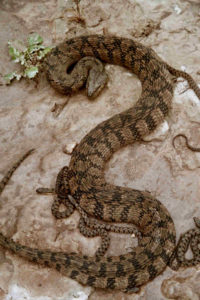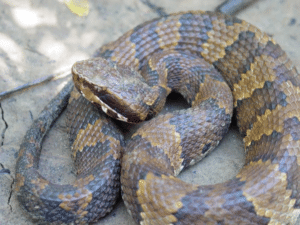As pond managers, we are often asked about snakes sighted in and around ponds and lakes. These creatures roamed the earth way before us and ongoing land development has led to the loss of much of their natural habitat. Therefore, our slithery friends are encountered more and more often in urban environments. Many community storm-water retention ponds provide a perfect place for snakes to forage, grow, and reproduce. It is also not uncommon for them to take up temporary residence in the swimming pool!
Due to the attached stigma, many people believe that any snake is a bad snake. However, it is important to distinguish between venomous water moccasins (a.k.a. western cottonmouth) and practically harmless watersnakes. More than 95% of the snakes sighted in urban retention ponds are of the latter variety.
The most common watersnakes in the Dallas/Fort Worth area belong to the genus Nerodia and are commonly referred to as the diamondback watersnake, blotched watersnake, and plain belly watersnake. These harmless species share similar body markings and physical characteristics with their venomous cousin. As a result, they are often misidentified.

Diamondback Watersnake (image courtesy of University of Texas at Arlington)
Watersnakes are found throughout the central United States and thrive in shallow community ponds, creeks, and ditches all across North Texas. Though all watersnake species can appear ominous when threatened, they actually pose little to no harm. These snakes are an important part of the ecosystem and can help reduce the numbers of some pest species. They are most likely to be encountered during the day; especially during the springtime mating season. They can range in color from olive green, brown, to black and have darker bands or splotches along the length of the body. Some water snakes have been recorded to grow over 5 feet long.
On the other hand, the western cottonmouth is a venomous pit viper. Though their natural range includes the Dallas/Fort Worth area, you are more likely to cross paths with a cottonmouth in east Texas or one of the southeastern states. They prefer slow moving rivers, lakes, and marshes. Most adult cottonmouths are colored various shades of brown with darker colored cross-bands. Like watersnakes, they can also reach 5 feet in length. The cottonmouth is more inclined to react by biting whenever it feels threatened. In the United States, one person per year dies from the bite of a cottonmouth (ref. University of Texas at Arlington, Amphibian and Reptile Diversity Research Center).

Western Cottonmouth (image courtesy of University of Georgia)
Both watersnakes and cottonmouths inhabit the same aquatic environments and feed on similar prey. Most of their diet consists of frogs and slow moving fish. They prefer the smooth, scale free skin of catfish. This makes young catfish a prime menu item!
Watersnakes and cottonmouths are similar in color and both can have banded body patterns. So how do you tell them apart? Here are a few of the more noticeable differences:
- Cottonmouths have a thick, muscular body with significant “narrowing” around the neck area. Watersnakes have a long, slender body that changes very little in its transition to the head.
- Cottonmouths have a “blocky” head with angular features. Watersnakes have a narrower head with more rounded features.
- Cottonmouths typically have a short, thick tail. Watersnakes have an elongated, heavily tapered tail.
- Watersnakes are usually colored yellow under the chin and body. Cottonmouths are more often shaded light brown or gray in those areas.
So next time you happen upon a snake sunbathing at the edge of your pond, think twice before you go into panic mode and reach for the closest weapon. Regardless of the species, it is highly unlikely that they pose an imminent threat. Keep in mind that he is probably just as scared as you are. Walk away cautiously in a non-threatening manner and he will more than likely return the favor. Learning to coexist with these hair-raising serpents promotes a healthier and more diverse ecosystem.
